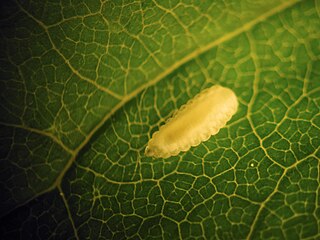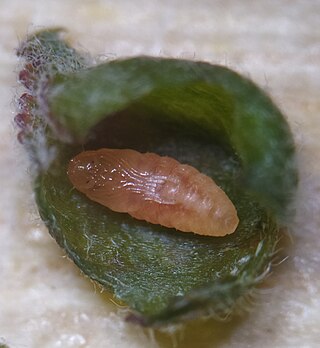
Cecidomyiidae is a family of flies known as gall midges or gall gnats. As the name implies, the larvae of most gall midges feed within plant tissue, creating abnormal plant growths called galls. Cecidomyiidae are very fragile small insects usually only 2–3 mm (0.079–0.118 in) in length; many are less than 1 mm (0.039 in) long. They are characterised by hairy wings, unusual in the order Diptera, and have long antennae. Some Cecidomyiids are also known for the strange phenomenon of paedogenesis in which the larval stage reproduces without maturing first. In some species, the daughter larvae consume the mother, while in others, reproduction occurs later on in the egg or pupa.

The Lasiopteridi is a supertribe of flies from the family Cecidomyiidae. They are often called gall midges or gall gnats.

The nettle pouch gall develops in leaf veins, leaf petioles, flower stalks and sometimes the stem of Urtica dioica. This structure is caused by the gall midge Dasineura urticae, sometimes misspelled Dasyneura urticae. Obsolete synonyms are Perrisia urticae and Cecidomyia urticae.

Dasineura crataegi, the hawthorn button-top gall-midge, is a dipteran gall-midge. It causes the hawthorn button-top gall, which develops in the terminal shoots of common hawthorn, Crataegus monogyna Jacq., Midland hawthorn C laevigata (Poir.) DC and their hybrid, C × media Bechst. Synonyms are Perrisia crataegi and Cecidomyia crataegi.
Orseolia oryzae, also called the Asian rice gall midge, is a species of small fly in the family Cecidomyiidae. It is a major insect pest of rice. The damage to the crop is done by the larvae which form galls commonly known as "silver shoots" or "onion shoots". The rice plant is stunted and the seed heads fail to develop.
Dasineura is a genus of midges in the family Cecidomyiidae, some of which cause galls on plants such as Dasineura crataegi on hawthorn and Dasineura fraxinea on ash.

Dasineura carbonaria is a species of gall midges in the family Cecidomyiidae. It forms galls on Euthamia graminifolia.
Dasineura communis, the gouty vein midge, is a species of gall midges in the family Cecidomyiidae.
Dasineura crataegibedeguar is a species of gall midges in the family Cecidomyiidae.
Dasineura parthenocissi is a species of gall midge, insects in the family Cecidomyiidae. It forms galls on Parthenocissus quinquefolia. The gall can host the parasitic wasp Platygaster munita.
Dasineura trifolii, the clover leaf midge, is a species of gall midges, insects in the family Cecidomyiidae.

Dasineura pellex, the ash bullet gall midge, is a species of gall midge, insects in the family Cecidomyiidae.

Dasineura gleditchiae, commonly known as the honeylocust podgall midge, is a species of gall midge in the family Cecidomyiidae. Native to North America, it is an invasive species in parts of Europe. The honeylocust podgall midge is a pest of honey locust, forming galls on the foliage.

Polystepha pilulae, the oak leaf gall midge, is a species of gall midge in the family Cecidomyiidae. It is found in eastern North America.

Dasineura fraxini is a gall midge which forms galls on the leaves and petioles of ash. It was first described by Johann Jacob Bremi-Wolf in 1847.
Anabremia is a genus of gall midge in the family Cecidomyiidae. The six described species are found in the Palearctic and likely inquilines of Dasineura galls on plants in the legume family. This genus was first described by Jean-Jacques Kieffer in 1912.
Dasineura balsamicola are a species of midges in the family Cecidomyiidae. They are an inquiline of Paradiplosis tumifex.

Dasineura plicatrix is a species of gall midge, an insect in the family Cecidomyiidae, found in Europe. It was described by the German entomologist Friedrich Hermann Loew in 1850. The larvae feed within the tissue of bramble leaves, creating an abnormal growth known as a plant gall.

Dasineura mali, commonly known as the apple leaf curling midge, apple leaf midge [English], Cécidomyie du pommier [French], Appelbladgalmug [Dutch], or Apfelblattgallen [German],is a species of gall midge belonging to the family Cecidomyiidae, within the order Diptera.











